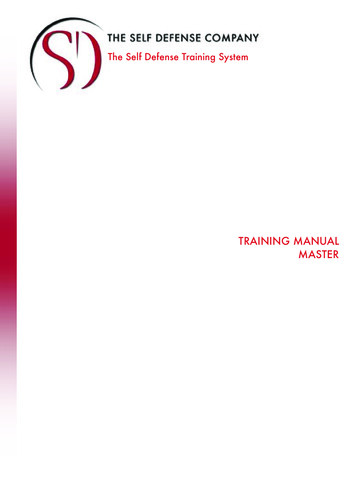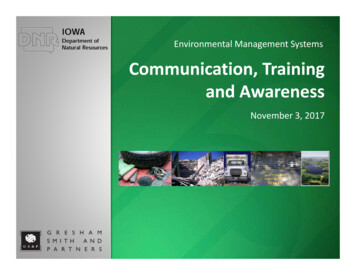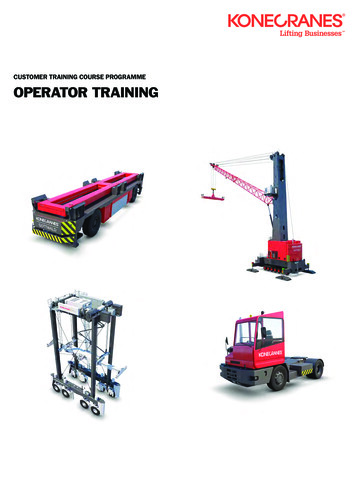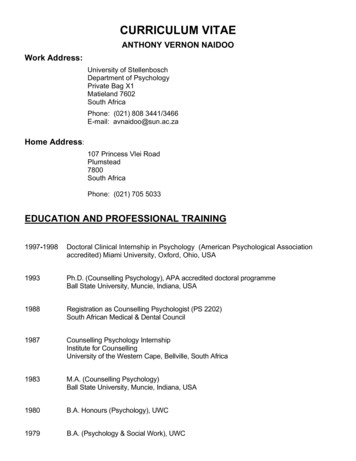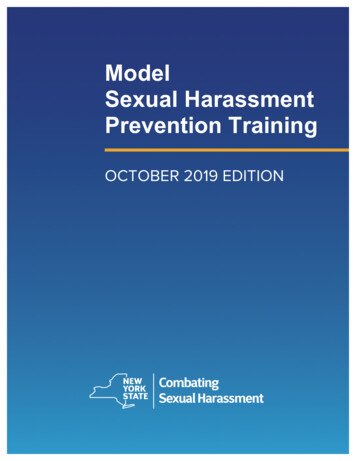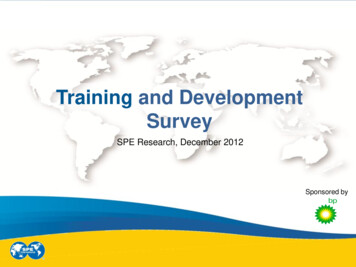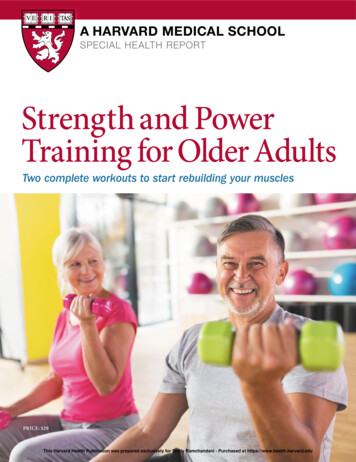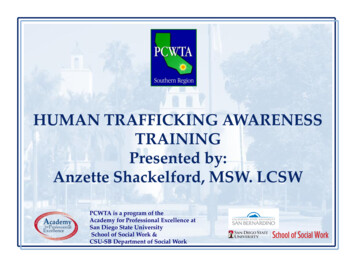
Transcription
HUMAN TRAFFICKING AWARENESSTRAININGPresented by:Anzette Shackelford, MSW. LCSWPCWTA is a program of theAcademy for Professional Excellence atSan Diego State UniversitySchool of Social Work &CSU-SB Department of Social Work
HUMAN TRAFICKINGCOMMERCIAL SEXUAL EXLOITATION OF CHILDRENand CHILD WELFAREFOCUS ON VICTIMS AND SURVIVORS OF TRAFFICKING ANDSEXUAL EXPLOITATION
Overview Define Human Trafficking Child Sex Trafficking- Sexual Abuse and Victims of Human Trafficking- Child Abuse and Neglect and Victims of Human Trafficking Trafficking Assessment Trauma-Sensitive Response
LEARNING OBJECTIVES1. Define human trafficking and the commercial sexual exploitationof children and how they are related.2. Describe the dynamics involved that contribute to thevictimization of young people by sex traffickers.3. Identify tools that may be utilized in the identification andassessment of victims of trafficking.4. Identify and highlight programs designed to intervene, assessand treat those affected by the commercial sexual exploitationof children.
WHAT IS HUMAN TRAFFICKING?
Defining Human Trafficking?According to the FBI Human trafficking is defined as, “The recruitment, transport,transfer, harboring or receipt of a person by such means as threat or use of force or otherforms of coercion, of abduction, or fraud or deception for the purpose of exploitation.”Trafficking consists of three core elements:1) The action of trafficking which includes any of the following: recruitment,transportation, transfer, harboring or receipt of persons.2) The means of trafficking which includes threat or use of force, deception, coercion,abuse of power or position of vulnerability.3) The purpose of trafficking which is always exploitation. Exploitation shall include, at aminimum, the exploitation of or the prostitution of others or other forms of sexualexploitation, forced labor or services, slavery or practices similar to slavery, and/orservitude .
The A-M-P ModelAction Recruits Harbors Transports Provides Obtains or soattemptsMeans* Force Fraud CoercionPurpose CommercialSex Acts Labor orServices*Proof of force, fraud & coercion are not required for prosecution underfederal mandates for minors under the age of 18 engaged in commercial sex.
True or False?Trafficking victims must be foreign nationals.FALSETrafficking victims can be either US citizens orforeign nationals. According to the TVPA(Trafficking Victim Protection Act) of 2000, bothare equally protected under federal law.
True or False?Trafficking requires a state or internationalborder-crossing.FALSEAlthough transportation may be involved andalthough the word connotes movement, the legaldefinition of trafficking does not requiretransportation.Trafficking is a crime against a person,not necessarily against a border.
True or False?If a trafficked person consented before theabuse or was paid, it can still be trafficking.TRUEConsent prior to an act of force, fraud orcoercion is not relevant, nor is payment.A minor in commercial sex is automatically atrafficking victim.
True or False?Elements of physical restraint or kidnappingmust be present for it to be trafficking.FALSEThe legal definition of trafficking does notrequire physical restraint. Psychologicalcontrol can be sufficient.
Myths and Misconceptions Myth #1: Trafficking requires travel and the crossing ofinternational or state borders. Myth #2: Trafficking victims are only immigrants or foreignnationals. Myth #3: There must be physical restraint, physical force, orphysical bondage present for it to be considered trafficking. Myths #4: If a trafficked person consented before the abuse orwas paid, it is not trafficking.
Commercial Sexual Abuse of Children (CSEC)AndDomestic Minor Sex Trafficking (DMST)What’s the Difference?The World Congress against Commercial Sexual Exploitation of Children definesCSEC as:“Sexual abuse by the adult and remuneration (pay for work or service) incash or kind to the child or a third person or persons. The child is treated asa sexual object and as a commercial object.”Domestic Minor Sex Trafficking (DMST) is defined by the Trafficking VictimsProtection Act as:“The recruitment, harboring, transportation, provision, or obtaining of aperson for the purpose of a commercial sex act” where the person is U.S.citizen or lawful permanent resident under age 18.
Global Human TraffickingThe UNODC Global Report on Trafficking in Persons looks at the crime of humantrafficking. It reports these key findings: Women account for 55-60 %of all trafficking victims detected globally; women and girlstogether account for about 75 per cent. 27% of all victims detected globally are children. Of every three child victims, two arefemale and one is male . Trafficking for sexual exploitation is more common in Europe, Central Asia and theAmericas. Trafficking for forced labor is more frequently detected in Africa and the MiddleEast, as well as in South and East Asia and the Pacific. Trafficking for the purpose of sexual exploitation accounts for 58 % of all trafficking casesdetected globally, while trafficking for forced labor accounts for 36%. The share ofdetected cases of trafficking for forced labor has doubled over the past four years. Victims trafficked for begging account for about 1.5 per cent of the victims detectedglobally. Trafficking for the removal of organs has been detected in 16 countries in allregions of the world.
Human Trafficking OverviewSex TraffickingThe recruitment, harboring,transportation, providing orobtaining of a person for acommercial sex act, in whichthe sex act is induced by forcefraud or coercion or in whichthe person induced to performsuch an act has not attained 18years of age.Labor TraffickingThe recruitment, harboring,transportation, provision orobtaining of a person for laborservices, through the use offorce, fraud or coercion for thepurpose of subjection toinvoluntary servitude, debtbondage or slavery.
3 Categories ofHuman TraffickingThose 18 or overinvolved incommercial sex viaforce fraud orcoercion.Minors inducedinto commercialsex.Adults or minorsin forced labor,services orinvoluntaryservitude viaforce, fraud orcoercion.
FORCE-Beating/Slapping-Beating with Objects (bat,tools, chains, belts,hangers, canes, cords)-Burning-Sexual Assault-Rape/Gang Rape-Confinement/Locked in-Torture Practices-Seasoning/InitiationFRAUD-False promises-Deceitful enticing andaffectionate behavior-Withholding wages-Lying about workingconditions-Lying about the promiseof “a better life”-Preying on desperationand poverty-Blackmail, extortionCOERCION-Threats of serious harmor restraint-Threatened abuse of legalprocess-Intimidation/Humiliation(Pimp circle)-Emotional Abuse-Climate of Fear-Modeling abusivebehavior-Controlling daily life skills-Creating dependency-Establishing quotas
Smuggling vs. Human TraffickingSmuggling A crime against a country’sborders. Illegal border crossing. Often transportation only. Can be a gateway totrafficking.Human Trafficking A crime against a person. Involves forced labor orcommercial sex acts. Transportation can be anelement but is notrequired. Smuggling debt can beused as a means of control.
Trafficking LocationsSex Trafficking Street Prostitution Massage Parlors Residential Brothels Escort Services Online Exploitation Hotels & Motels Truck Stops Exotic Dancing/Stripping PornographyLabor Trafficking Domestic Servitude Agriculture, Forestry,Fishing Construction Peddling & Begging Rings Factories Service Industry (hotels &restaurants) Small Businesses
CHILD SEX TRAFFICKING
MAKING OF A GIRLhttp://www.youtube.com/watch?v ZvnRYte3PAk
Group ActivityWhat are some things you and/or societyassociate with these words“PIMP”“PROSTITUTE”
Commercial Sexual Exploitation ofChildren in the US An estimated 200,000 American children are at risk for traffickinginto the sex industry. Estimates vary but most experts would agree that over 100,000children in the US are victims of commercial sexual exploitation. As many as 2.8 million children in the U.S run away from homeeach year. Within 48 hours of being on the street , 1/3 of runaways in theU.S may be lured or recruited into the underground world ofprostitution and/or pornography. 12-14 years is the average age girls enter CSEC 11-13 Average age boys enter CSEC LGBT youth are also at risk for CSEC
Male Trafficking Victims Sex trafficking of boys is often hidden . The average age for boys entering into domestic minor sextrafficking is 11-13 years Across the nation and the globe migrant boys are vulnerable tosexual exploitation Authorities may fail to identify male victims due to lack oftraining and a focus on female victims
The Pimp Subculture
Popular Culture “Pimp” used to refer to making things better.– Pimp My Ride, Pimp My Profile
Types of Pimps Gorilla Pimp: a pimp keeps who controls through theuse of fear, violence and coercion Finesse Pimp: lures victims with smooth talk and falsepromises. Romeo/Boyfriend Pimp: cons vulnerable young womeninto a relationship with them, pretending to care forthem Popcorn Pimp: has very few girls/women in his “stable”and his considered to have very little knowledge of thepimp game and is ridiculed by other types of assification
The Pimp Subculture Complex relationship between male (sometimesfemale) pimp and one or more women and/or girls. The pimp wields complete control and dominationand induces commercial sex acts in order to makemoney. The pimp uses intense manipulation, feignedaffection, brutal violence, and verbal, psychologicaland/or emotional abuse to gain complete control. Motivated primarily by the pursuit of money, all ofwhich he keeps.
Reality
RealityJason Itzler, SelfProfessed “Pimp-King”
Rules & Techniques The Term “Daddy”: Women and girls under a pimp’s controlmust never know his real name or identity and refer to himexclusively as “daddy.” Eye Contact: A woman or girl may not ever make eye contactwith another pimp. If this rule is broken, the woman or girlsuffers serious physical violence. Sidewalks and Streets: As indicated by the term “Pimps Up,Hos Down,” women and girls must always exist in “lower”ways than the pimp, including by standing only on the streetduring street prostitution. Quotas: Pimps set nightly monetary quotas that the womenor girls must reach through providing commercial sex or theft.
Language & Terminology “Daddy”—used to describe one’s own pimp. “Bottom” or “Bottom Bitch”—the woman who’s been withthe pimp the longest and often takes on a mid-levelcontrolling role to keep other victims in line. “Dates,” “Johns,” and “Tricks”—terms used to describe buyersof commercial sex. “Square”—a term used that describes trying to go straightand get out of the life, or that describes law enforcement andthose who don’t understand “the game.” The “Stroll,” “Track” or “Blade”—the common area or crossstreets where street prostitution is known to occur on anightly basis.
Language & Terminology “Pimp Circle”—the process of multiple pimps swarming andsurrounding one woman or girl and hissing insults at her, forthe purposes of humiliation and intimidation. “Wife in Law” or “Wifey”—each individual in a group ofwomen or girls that are with the same pimp. “Family” and“folks” are synonyms. “Stable”—refers to the group of women and girls under apimp’s control. “Out of Pocket”—a term used to describe when a woman orgirl breaks “the rules” by making eye contact with anotherpimp.
Recruiting BehaviorPimps manipulate their victims beginning with an initial periodof false love and feigned affection. This initial period is criticalto attaining long-term mind control and includes: Warmth, gifts, compliments and sexual and physical intimacy. Elaborate promises of a better life, fast money, and futureluxuries. Purposeful and pre-meditated targeting of vulnerability (e.g.,runaways, thrownaways) Purposeful targeting of minors due to naiveté, virginity andyouthful appearance.
Recruiting LocationsPimps are known to engage in constant recruiting to attempt toentice women and children into their web of control.Common recruiting locations include: Junior high and highschools Courtrooms Hallways of courtbuildings Foster homes Bus stationsGroup homesHomeless sheltersHalfway housesRestaurants and barsParks and playgrounds
Familial Sex Trafficking The trafficker:– Parent or guardian, intimate partner or other immediateor extended family member.– May have previous involvement in commercial sex. Abuse of power dynamics Sex and labor trafficking May be a push factor for children who arerepeat runaways
Latino Residential Brothels Victims: Latina women, minors Controllers: Male & Female Latinos Recruitment: False Job Promises,Smuggling, Boyfriend, FamilyMembers Clientele: Latino Males Price: 30 for 15 min Locations: Residential areas, RuralTrailers, Apartments Other Fronts: Cantinas and EscortDelivery Advertising: Word of Mouth,Business Cards
Sexual Exploitation of ChildrenVia Technology Backpage Craigslist MyRedBook.com MyPinkBook.com Social Media websites Mobile Applications
VIDEO:HUMAN TRAFFICKING ANDCSEC COMMERCIAL SEXUALEXPLOITATION OF CHILDRENhttp://www.youtube.com/watch?v fFRZ1NDR0Rc
“Seasoning”The process of “breakingdown” a girl from havinghealthy adolescent sexualboundaries to havingcommercial sex withstrangers is often referredto as “grooming” or“seasoning.”It is a systematic process thathas been documented andreplicated by pimpsnationwide.
“Seasoning” Beating/Slapping/Whipping Burning of personal items or the victim Sexual Assault—Rape or gangrape Confinement Other torture techniques Emotional AbuseRe-namingCreating dependenciesRemoval from familiarity andsupport structuresDocument confiscationForced sexual education by wayof forcing victim to watchpornography
The Role of MoneyBoiled down to its very essence, money is oftentimesthe primary motivating factor driving pimp behavior.Quotas Typically fall in the range of 500- 1,000 each night. Victim must reach these quotas by whatever meansnecessary in order to eat or sleep. Strictly enforced. Punishment is severe. Victim keeps none of the money. 100% of the profitsgo to the pimp.
Based on the low end of thequotas: 500/night X 7 nights a week X5 girls/women 890,000Per year
The Trauma Experience x 25 per day x 7 days/week x 1 year 8,900 rapes per year
Who are the buyers?Johns /Tricks aka Solicitors of CSEC US citizens Foreign nationals Any race or ethnicity Range of ages Diverse socioeconomic backgrounds Primarily men – most of which are in long term romanticrelationships Women who also purchase sex from youth (boys and girls) Most buyers (75%) indicate they purchases sex for the firsttime between the ages of 16-25 years oldANYONE
Who are the buyers?Johns can be: US citizens or foreign nationals Any race or ethnicity Range of ages Diverse socioeconomic backgrounds Primarily menANYONE
Where does it occur?Locations can be: Street Prostitution Truck Stops & Rest Stops Online Solicitation In-home Services Escort Services orDelivery Services
Red Flags & IndicatorsAn expressed interest in, orin relationships with adultsor older menInconsistencies in their storyabout where they stay or whois their guardianFrequenting of internetchat rooms or sites thatadvertise commercial sexConstant communication withmultiple menUnexplained shopping tripsor possession of expensiveclothing, jewelry, or a cellphoneReluctance to explain atattoo/brandingUse of lingo or slang from“the life” among peers, orreferring to a boyfriend as“Daddy”Keeping late-nights or unusualhours and vaguenessconcerning whereabouts
Identification of CSEC Youth Chronic runaway/homeless youth Excess amount of cash in their possession (may be reluctant to explain its source) Hotel keys and key cards Lying about age/false ID Inconsistencies when describing and recounting events Unable or unwilling to give local address or information about parent(s)/guardian Presence or fear of another person (often an older male or boyfriend who seemscontrolling) High number of reported sexual partners at a young age Sexually explicit profiles on social networking sites Injuries/signs of physical abuse (that they may be reluctant to explain) Inability or fear of social interaction Demeanor exhibiting fear, anxiety, depression, submissiveness, tenseness, nervousness Is not enrolled in school or repeated absence from school Does not consider self a victim Loyalty to positive feelings toward pimp/trafficker May try to protect pimp/trafficker from authorities Prepaid cell phones/Prepaid cash cards Tattoos or branding of Traffickers name and/or items that denote financial gain i.e. : dollarsigns that are visible on the neck, face, or other areas.
Examples: Tattooshttps://www.google.com/search?q tattoos and prostitution&biw 1360&bih 667&source lnms&tbm isch&sa X&ei 8A9EVM VD8O1yATAlQE&ved 0CAcQ AUoAg#tbm isch&q pimp branding and tattoos
Activity – Self Reflection What were you wearing at this age? What was your favorite song or musical group? How did you identify yourself? Who did you trust?
Intersection of CSEC and Child Welfare Approximately 90% of CSEC victims haveprevious history of child abuse and neglect Estimates indicate that 50-85% of childreninvolved in CSE have history with the childwelfare system prior to exploitation Youth who have experienced sexual abuse are28 times more likely to be exploited than theirnon-abused counterparts
Additional Risk Factors forFoster Care Youth Prior history of abuse and/or neglect Lack basic support systems, basic needs Often come from communities impacted by bothpoverty and violence and where exploitation maybe prevalent. May leave placements and find themselveshomeless May suffer from trauma related mental healthissuesTRAFFICKERS TARGET THESE VULNERABILITIES
More on CSEC and Foster Care YouthEstes & Weiner (2001) found that in the United States, the primary causes ofCSEC are: Family dysfunction (Substance Abuse, DomesticViolence, Criminal History) Family sexual assaults Family or personal drug dependence, or School or other social failures
Why don’t they seek help? Captivity/Confinement – locked indoors, locked in rooms, locked inclosets Frequent accompaniment/guarded – interactions are monitored orcontrolled by the pimp Use and threat of violence – severe physical retaliation (beatings,rapes, sexual assault) Fear – of physical retaliation, of death, or of arrest Use and threat of reprisals against loved ones – against children orfamily members Shame – about the activities they have been forced to perform Self-blame – brainwashed by the pimp to blame themselves Dependency – on the pimp after years of control
Why don’t they seek help? Debt bondage – may have a debt to the pimp that they feel they need topay off Loyalty to the pimp – Stockholm syndrome, similarities to BatteredWomen’s Syndrome Social barriers and unfamiliarity with surroundings – due to frequentmovement No personal ID or documentation – which is often confiscated by thepimp Distrust of law enforcement – brainwashed to fear law enforcement bythe pimp or learned distrust of law enforcement due to direct negativeexperiences
Why don’t they seek help? Isolation – from others, from other support structures, from means ofrelief Misinformation and false promises – have been told lies or deceitfulinformation Lack of knowledge of social systems – may not understand social serviceinfrastructure or how and where to access help
Stockholm Syndrome, Trauma Bonds and CSECDenialSearch forControlLack ofSelf Denies anger at trafficker to others and self Denies occurrence of violence Rationalizes violence/Blames self for abuse Believe that they have some control over abuse Believe if they control situation it lessons trafficker/customerscontrol and abuse Tries to get into traffickers/customers head May or may not have own perspective Experiences sense of self through traffickers/customers eyesEmpathywithTrafficker Sees world through trafficker’s perspectiveSees trafficker as a good person/ protectorSees trafficker as a victim of circumstancesIs thankful trafficker/customer has not killed themSees outside authorities as a threatOthers Shows ongoing signs of trauma or PTSDIntensely and overly grateful for small acts of kindnessHyper vigilant to traffickers needsSeeks to keep trafficker happy to decrease violence
Why is it hard to identify victims? Frequent movement – may not be in one place long enough to form socialconnections Distrust of service providers – generalized impressions and perceivedjudgmental attitudes Lies and false stories – may be self-generated or trained to tell lies, fakenames, fake SSN Rarely come into contact with institutional systems – that are designed tohelp them Low likelihood of multiple encounters – within institutions or throughdoing outreach
Human Trafficking (CSEC) and Sexual Abuse 60-80% of prostituted persons were sexually abused as children 57-75% were physically abused. (Shively et al., 2010) An estimated 1 in 12 children and youth nationally haveexperienced sexual victimization. Approximately 97% of children and youth with any sexualvictimization will experience future victimization. (Finkelhor et al.,2005) The odds of survival sex are significantly increased for youths whohave been previously victimized. (Greene et al, 1999) Sexual abuse is the most common reason for children running awayfrom homeThese are the youth most at-risk for becoming victims ofCSEC.
Providing a Trauma-Sensitive Response Use a calm voice Let the client lead– Allow silence– Ask open-ended questions Set boundaries:– “I would like to help you, in order to do so I need you to calmdown.” Avoid re-traumatization– How much detail is enough? Be non-judgmental– Don’t say: “Why didn’t you leave?”– Do say: “What would happen if you left?”Create a Safe Space
Mental Health Effects & theImportance of Counseling Post-Traumatic Stress Disorder (PTSD) Depression Disconnection from feelings and flat affect Anxiety disorders Self-blame Hopelessness, helplessness Nightmares – dreams of rapes,sexual assaults, physical abuse Anger and anger managementissues Suicidal ideation andattemptsParanoiaStockholm SyndromeSpiritual disruptionFatalism and rageDual diagnosisSelf-care issuesSleeping issuesDissociative disorders
Service Needs Emergency, Transitional,and Long-term housing Legal services Medical and Mentalhealth services Clothing and food Court and dailyaccompaniment Crisis intervention Emotional support andcounseling Employment assistance Protection/safetyplanning Social service advocacy Transportation Literacy education(school, G.E.D.) Assistance in accessinggovernment benefits
Using this information inYour daily practice Know the signs identify and assess Develop a strategy for intervention and safetyplanning Inform and Educate Collaterals
Helpful Activity Helpful exercise to do with staff or clients.Identify the stigmas and stereotypes youth or staffmight hold.– Compare the terms “child prostitute” vs. “traffickingvictim”– Inform all stakeholders that according to the TVPA,anyone under 18 who participates in commercial sexis a victim of trafficking (not a prostitute)
REMEMBER .THERE IS NO SUCH THING AS:ATEENAGEPROSTITUTE!
Within 48 hours of being on the street , 1/3 of runaways in the U.S may be lured or recruited into the underground world of prostitution and/or pornography. 12-14 years is the average age girls enter CSEC 11-13 Average age boys enter CSEC LGBT youth are also at risk for CSEC Commercial Sexual Exploitation of Children in the US


